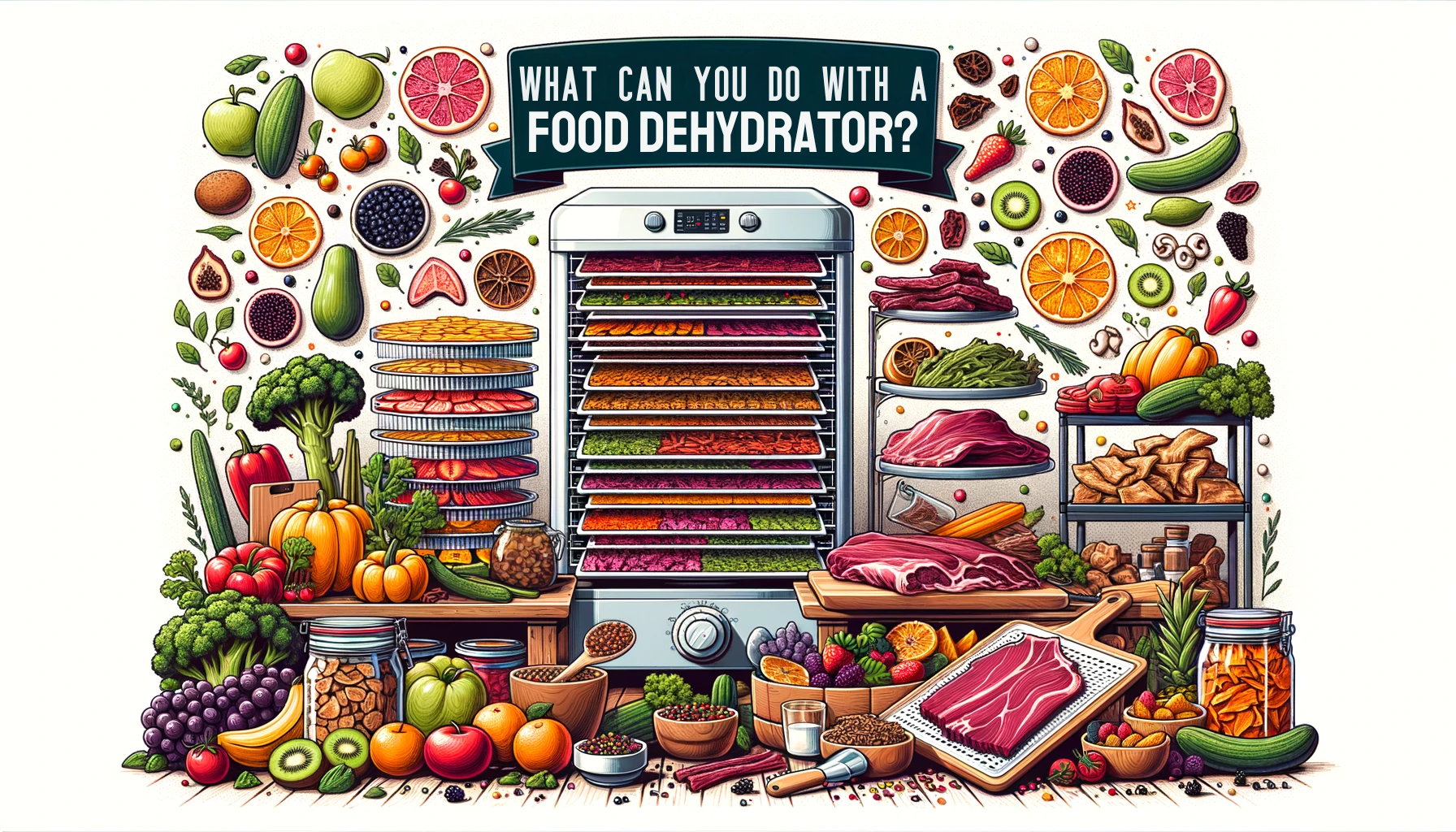In the world of food preservation, it’s easy to get confused when it comes to the different techniques and tools available. One question that often arises is whether food dehydrators and freeze dryers are interchangeable or if they serve different purposes. While both methods aim to remove moisture from food, there are significant differences between them that can make all the difference in your cooking and culinary adventures. So, let’s clarify the distinctions between food dehydrators and freeze dryers, so you can make an informed decision when it comes to preserving your favorite ingredients.
What are Food Dehydrators?
Definition
Food dehydrators are kitchen appliances used to remove moisture from various types of food, including fruits, vegetables, meats, and herbs. By using a steady heat source and air circulation, these devices gently dry out the food while preserving its nutritional value and flavor.
Working Principle
Food dehydrators operate by circulating warm air evenly around the food at a low temperature. This process promotes the evaporation of moisture, allowing it to escape from the food slowly. The dehydrator’s fan ensures that the air circulates uniformly, ensuring consistent and efficient drying.
Benefits
There are numerous benefits to using a food dehydrator. Firstly, dehydrated foods have an extended shelf life, making them an excellent option for long-term storage. Secondly, by removing moisture from food, dehydrators inhibit the growth of mold, bacteria, and yeast, reducing the risk of spoilage. Additionally, dehydrated foods retain most of their original nutrients, making them a healthier alternative to processed snacks. Lastly, dehydrated foods are lightweight and portable, making them ideal for camping trips, hiking adventures, or as on-the-go snacks.
What are Freeze Dryers?
Definition
Freeze dryers, also known as lyophilizers, are advanced machines used to remove moisture from various perishable items, including food, pharmaceuticals, and biological samples. Unlike food dehydrators, freeze dryers employ a sophisticated freeze-drying technique that preserves the texture, taste, and nutritional content of the food.
Working Principle
Freeze dryers work by subjecting the food to extremely low temperatures and reducing the surrounding pressure. This process, known as sublimation, converts the moisture directly from solid (ice) to gas (water vapor) without going through the liquid phase. By carefully controlling the temperature and pressure, freeze dryers remove almost all the moisture, leaving the food with a dry, lightweight, and crispy texture.
Benefits
The use of freeze dryers provides several advantages. Firstly, freeze-dried foods have an incredibly long shelf life, often lasting years without the need for refrigeration. This extended shelf life makes them an ideal emergency food source or a reliable option for those who enjoy stockpiling supplies. Secondly, the freeze-drying process retains the food’s original taste, aroma, and texture, ensuring a high-quality product. Lastly, freeze-dried foods rehydrate quickly when exposed to water, making them convenient for quick meal preparations and preserving its nutritional value.
Differences between Food Dehydrators and Freeze Dryers
Method of Dehydration
The primary difference between food dehydrators and freeze dryers lies in their methods of dehydration. Food dehydrators use a low heat and circulating air to slowly remove moisture from the food, while freeze dryers utilize sublimation, where moisture is extracted through the conversion of ice to water vapor without becoming a liquid.
Time Required
Food dehydrators generally require more time for the dehydration process compared to freeze dryers. The duration of dehydration can range from a few hours to a few days, depending on the moisture content and thickness of the food. On the other hand, freeze dryers quickly remove moisture within a shorter period, typically several hours to a day, due to the sublimation process.
Nutritional Content
While both food dehydrators and freeze dryers preserve the nutritional content of the food to some extent, freeze dryers are generally more effective in retaining the original nutrients, flavors, and textures of the food. The freeze-drying process minimizes damage to enzymes, vitamins, and minerals, resulting in a final product that closely resembles the fresh counterpart. However, food dehydrators can still retain a significant amount of nutrients, albeit at a slightly reduced level.
Cost
In terms of cost, food dehydrators are typically more affordable compared to freeze dryers. Food dehydrators are readily available in various sizes and models, with prices ranging from $30 to $300, depending on the features and capacity. On the contrary, freeze dryers are more expensive due to their advanced technology and specialized capabilities. The prices for freeze dryers can start from $2,000 for home-use models, but industrial-grade freeze dryers can cost tens of thousands of dollars.
Space Requirements
Food dehydrators are generally compact and take up minimal counter or storage space. They are available in different sizes, allowing users to choose one that fits their needs and available space. Freeze dryers, on the other hand, tend to be bulkier and require more space due to their complex machinery and additional components, such as vacuum pumps and condensers.
Similarities between Food Dehydrators and Freeze Dryers
Preservation Method
Both food dehydrators and freeze dryers are effective preservation methods for perishable food items. By removing moisture, they inhibit the growth of mold, bacteria, and yeast that cause spoilage. Both methods result in dried food that can be stored long-term without the need for refrigeration.
Long Shelf Life
One common characteristic of both food dehydrators and freeze dryers is their ability to extend the shelf life of food. Dehydrated and freeze-dried foods can last for months or even years, depending on the food type and storage conditions. This feature makes them suitable for emergency preparedness, as well as for individuals who want to minimize food waste and save money by buying in bulk.
Reduced Food Waste
Both food dehydrators and freeze dryers contribute to reducing food waste. By preserving food through dehydration, they allow for the utilization of surplus or overripe produce that would otherwise go to waste. Moreover, when stored properly, dehydrated or freeze-dried foods have a longer shelf life, preventing unnecessary spoilage and minimizing food wastage.
Food Preparation
Both dehydrated and freeze-dried foods are versatile ingredients that can be conveniently used in various recipes. Whether it’s adding dehydrated fruits to homemade granola or incorporating freeze-dried vegetables into backpacking meals, these preserved foods are flexible and easy to incorporate into cooking and baking. The lightweight and compact nature of dehydrated and freeze-dried foods also make them an excellent choice for camping, hiking, or any other outdoor activities where minimal storage space is available.
In conclusion, while food dehydrators and freeze dryers share similarities in terms of their preservation methods, long shelf life, reduction of food waste, and food preparation convenience, there are notable differences in their methods of dehydration, time required, nutritional content, cost, and space requirements. It is important to consider these factors when choosing between the two depending on personal needs, budget, and desired outcome. Whether opting for a food dehydrator or a freeze dryer, both devices offer unique benefits that enhance food preservation and provide a range of versatile options for enjoying delectable and nutritious meals.


